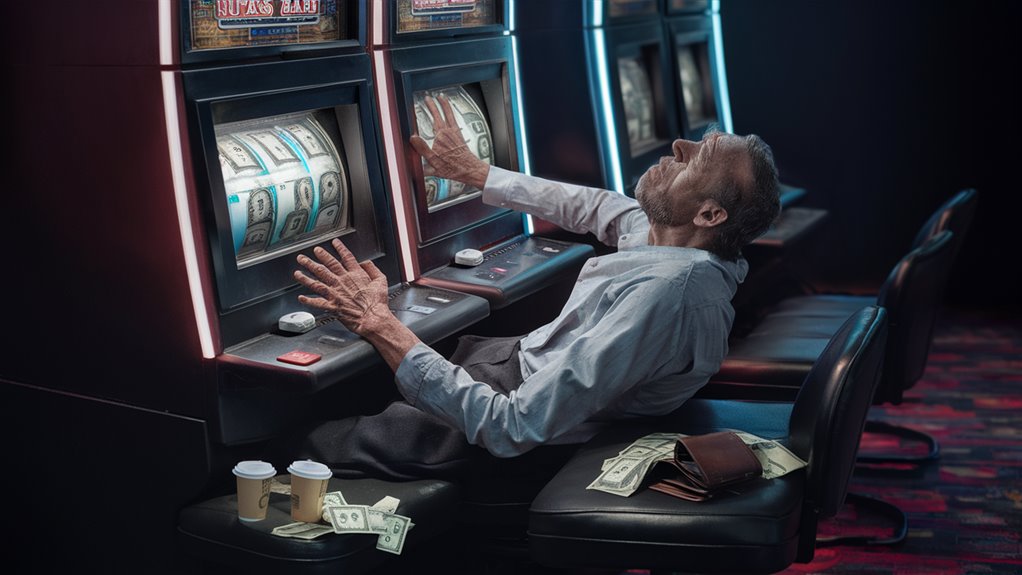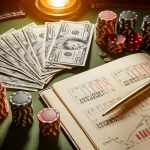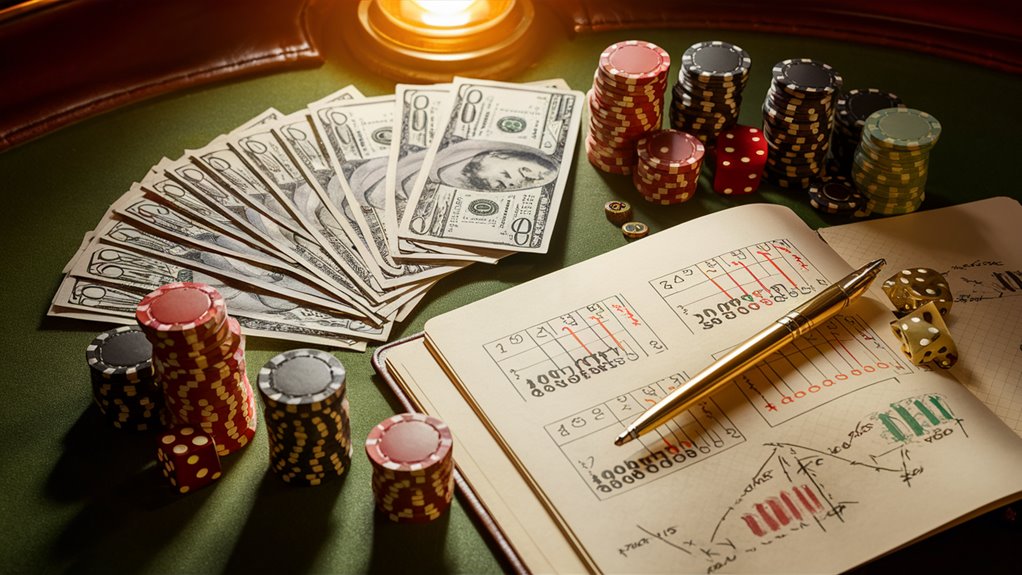Why Do People Continue to Chase Gambling Losses, Even After They Have Lost All Their Money?
The Neuroscience Behind Loss Chasing
It is complex neurological processes that drive loss chasing behavior in gambling. When gamblers suffer losses, the disruption of their dopamine pathways is so great that it forms patterns showing an extremely close resemblance to conventional substance addiction.
How does the brain hold up under such conditions? This neurological response immediately triggers an intense drive toward ever more gambling, no matter how much financial pain and damage it causes.
Psychological Factors and Cognitive Distortions
The Sunk Cost Fallacy: This cognitive bias can make gamblers believe they have to keep playing to recoup losses even after they are gone. Near-miss experiences activate reward centers within the brain that are identical to real wins, creating a false sense of almost winning which further reinforces bad betting patterns.
Social and Cultural Influences
The impact of social pressure and fear of admitting loss on gambling behavior is significant. Shrouded in stigma, gambling losses can push people to further risky wagers in a desperate, doomed attempt to regain their financial footing. Cultural attitudes toward personal finances and career success can only add to the weight of one’s gambling losses.
Breaking the Cycle
Understanding these neurological and psychological mechanisms is crucial for making effective interventions. Knowing how dopamine-driven rewards and cognitive biases affect behavior enables such gamblers to benefit from a more successful range of coping strategies and thus break free of their destructive betting styles.
Key Risk Factors:
- Stepping outside of established psychological tradition
- Reward system disruption
- Feelings of hopelessness and helplessness leading to cognitive biases and distorted thinking
These might also create better opportunities to change people’s mental approach to dealing with gambling risks because they spell out clearly who is most likely not getting their just deserts from betting, social stigma, and cultural pressure.
The Psychology Behind Loss Recovery
Neurological Response to Gambling Losses
When gamblers experience losses, their brains initiate a complex cascade of psychological responses aimed not only at repairing the financial damage but also at restoring emotional balance. The result is loss-chasing behavior. As the brain’s pleasure circuits become progressively less comfortable, losing hurts more than winning feels good! It encourages increasingly hazardous decisions in an attempt to recoup losses.
Key Psychological Mechanisms
Cognitive Dissonance: Cognitive dissonance is at the heart of things when gamblers find that their losses are increasing despite themselves. This internal contradiction prompts people to forget some of what they already know and focus on only the remaining information–past wins.
Near-Miss Effect: The near-miss phenomenon triggers the same neural pathways as actual wins, reinforcing continued gambling behavior. These last-minute but unsuccessful attempts at getting something done give people a powerful feeling of reinforcement. They think for ages afterwards about that one time they got close and didn’t get it, or at least should have gotten it.
Neural Activity During Loss Recovery
The loss-chasing process is often accompanied with an impairment in the brain’s dopamine system. While the prefrontal cortex, which governs rational decision making, exhibits decreased activity, emotional centers become more active at the same time. This neurological state of being sets up a dangerous loop where people are increasingly well prepared Velvet Veil Slots to make bad judgments in order to get back what they have lost.
Risk Factors and Warning Signs
- Following a loss, you’ll bet more
- You’ll make more emotional decisions, and fewer logical ones
- You will lose track of time while gambling
- You’ll lose your self-control
- You’ll get into more serious financial commitments
Effective treatment for these issues requires the intervention of medical professionals with a background in both psychology and neurology, as well as your active cooperation.
Understanding the Sunk Cost Fallacy
The Sunk Cost Fallacy in Gambling
The Psychology Behind Loss-Chasing Behavior: At the core of the sunk cost fallacy exists a fundamental cognitive bias that fuels this destructive gambling behavior. This psychological phenomenon leads people to behave in such a way, because they are laboring under the false impression that their sunk costs somehow justify future investment. Their mistaken belief that past expenditures constitute an excuse for carrying on spending compounds the hurt: this cycle is a disaster.
Key Mechanisms of the Sunk Cost Fallacy
Emotional Investment and Loss Recovery: The emotional attachment to losses appears in the form of a desire to recover money that has already been lost. Gamblers commonly have a compelling need to “make good” for this, and engage in increasingly poor betting patterns. This surge in emotion overrides rational thought.
Manipulating the Reward System: During gambling activities, the brain’s reward circuitry gets significantly changed. This neurophysical impact brings about a false hope that more play will eventually make up for previous losses. The resultant false hope is made even stronger by the dopamine response. This reinforces one of the vicious circles of gambling.
Mental Distortions
Probability Misconceptions and Gambling Delusions: Players tend to form erroneous beliefs about their prospects of winning, often seeing random events as meaningful but cause-and-effect series of events.
Escaping Sunk Cost Thoughts
Native Support: Why your past losses are irreparable is a key first step in overcoming the sunk cost fallacy. If lost money is seen as unrecoverable rather than an investment which must produce a return, future judgments about gambling activities are on a more rational basis. This fundamental change in perspective helps break the pattern of compulsive gambling behavior and forms healthier spending habits.
Near-Miss Effects on Decision Making
Near-Miss Effects in Gambling: Understand Why We Almost Win
This confusing near-miss experience in betting lights up like a jackpot in our brain’s reward system. Brain imaging experiments show that mere near-miss experiences activate a group of neural circuitry similar to win events, mainly the striatum regions and insula. The most notable neurological reaction is that there is a big release of dopamine. In this way, irrespective of any tangible proceeds, people naturally want to go further with gambling activities.

The Psychology of “Almost Winning”
The sensation of near-misses can be extremely potent in sustaining continuous gambling. When a gambler sees three matching symbols on a slot machine and just misses the third, the brain processes this outcome as skill involved rather than pure chance. Such cognitive distortions lead to the mistaken impression that the player has developed improved performance and is now near to winning.
Casino Design and Strategic Implementation
Casinos strategically control the near-miss frequency in games to capitalize on these mental vulnerabilities. Research shows that an optimum ratio of near-misses engages players most effectively and affords player satisfaction to the full. This approach to game design is aimed at making use of mental shortcuts and biases built into the mind, increasing gambling persistence.
Social and Cultural Pressure on Gambling Behavior
The Impact of Social and Cultural Pressure
Cultural Influences on Gambling Decisions: Societal expectations and cultural norms are powerful forces that shape gambling behaviors with subtle intertwining social mechanisms at work. Where gambling is culturally accepted and the environments people inhabit have gambling as a norm, pressure to gamble increases, especially when social standing and Mosaic of Embers Casino consensus norms about what constitutes success become linked with how much one gambles.
Key Manifestations of Social Pressure
Status and Reputation: Many people chase heavy deficits after large losses. The fear of losing face in public or appearing humble drives continuous gambling, especially in male-dominated places such as casinos and horse betting centers. In many cultures, success at gambling is associated with prosperity and fortune, creating further incentives for people to bet on in order to retain their social rank.
Peer Influence and Group Dynamics
Media portrayal of gambling success, while neglecting losses, further reinforces the idea that continual play is reasonable, regardless of the mounting costs.
Social Reinforcement Mechanisms
The intersection of cultural expectations and peer influence produces incredibly powerful reinforcement forces that perpetuate gambling habits. They function through such means as:
- Communal validation of habitual betting behavior
- Cultural beliefs about good and bad luck
- Social status associated with winning gambles
- Group pressure to maintain accumulated bet patterns
- Media influence on perceptions of gambling
Dopamine in Gambling
Getting to Know the Importance of Dopamine in Gambling
Dopamine, as the brain’s most important reward molecule, has powerful effects on the neural reward pathways that keep people coming back to do things that feel good for them. Neuroscience shows that betting causes patterns of dopamine release similar to those seen when going addicted. This biochemical feedback thrusts gambling habits into overdrive not only through those wins, but false near wins as well – and also lights up during anticipation of rewards.
Back to Normal Neurotransmission Methylation and Risk-Taking Behavior
Extended exposure to gambling inevitably brings changes in dopamine sensitivity throughout the mesolimbic system of the brain. As a result of these adaptations, gamblers are driven to stake more and more money on bets with odds increasingly stacked against them, leading to financial losses that endanger their families.
The Stress-Gambling Cycle
Medical Impact: When trouble strikes, the organism undergoes powerful stress reactions and secretes cortisol all over its body. As a result of this biological chain reaction:
- Decision-making power is traced by a large curve 먹튀검증
- Cognitive function is vastly impeded
Emotional Regression in Special Circumstances: This phenomenon explains the compulsive nature of continued gambling despite repeated losses. In this cycle of loss-inducing emotional dysregulation:
- Emotional disturbance drives gambling of high risk
- Poor decisions leading to more losses
- The stress becoming even worse for one’s judgment
- Fundamental breakthroughs in processing lead to intensified gambling activity
Break the Loss-Chasing Cycle
Breaking the Loss-Chasing Cycle: A Comprehensive Recovery Guide
Opting To – And Beating – Loss-Chasing Behavior: Loss-chasing is a mutually reinforcing gambling pattern. We will propose detailed, evidence-based intervention strategies that target both its psychological aspects and behavioral components. It gives concrete methods proven to be effective in helping people regain control.
Setting Strict Financial Limits: Set a fixed amount that you are going to gamble with at a casino before entering and then abide by this decision without deviation. When you reach your stopping point, do not place another bet–quit immediately regardless of what is happening around you.
Cognitive Changes In Beliefs
Loss-chasing behavior is driven by irrational beliefs about gambling. These errors in thought must be corrected in a systematic way. Selected points generally include:
- “If I keep going at this rate, I am due for a win”
- “If only one more bet then I can make my losses back”
- “It will be simple to earn a recovery from those past losses”
Developing Healthy Adaptation Strategy
An alternative way of coping becomes indispensable to the entire rehabilitation process. Active and passive ways of reducing stress, group involvement in professional counseling, and connecting to recovery infrastructure can greatly improve the chance of recovery. Frequent participants of Gamblers Anonymous meetings, skilled addiction therapy, and recovery from partners in accountability all help support this process.
Progress that is Lastingly Positive
Recovery requires consistent application of multiple strategies:
- Steps to check for progress on a regular basis
- Identify and manage triggers
- Ongoing support group attendance
- Continual skill promotion
If you already were to do so much, then one aspect of this could be to organize your finances.










